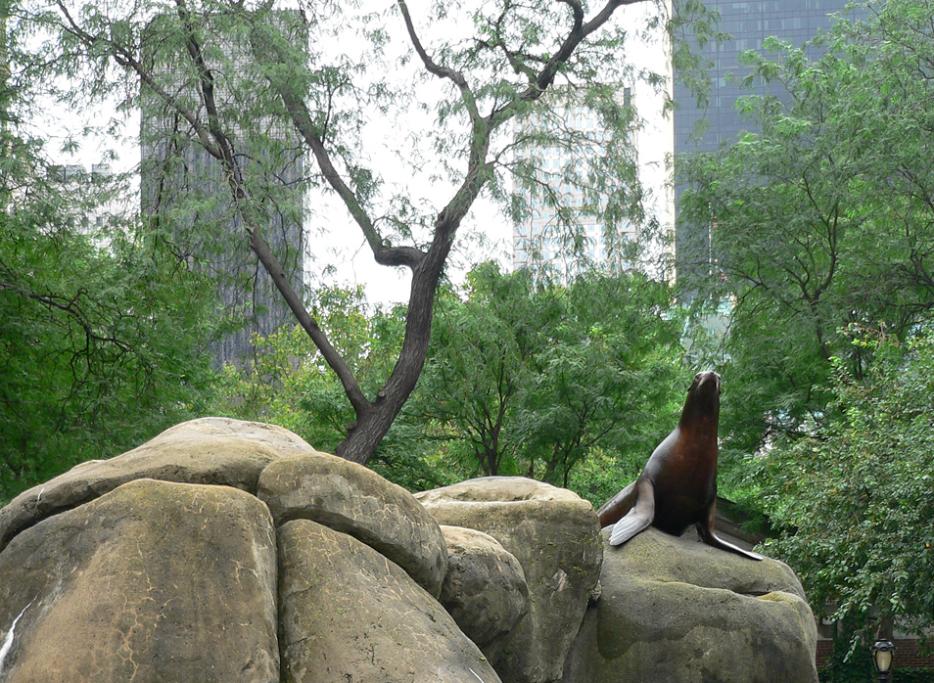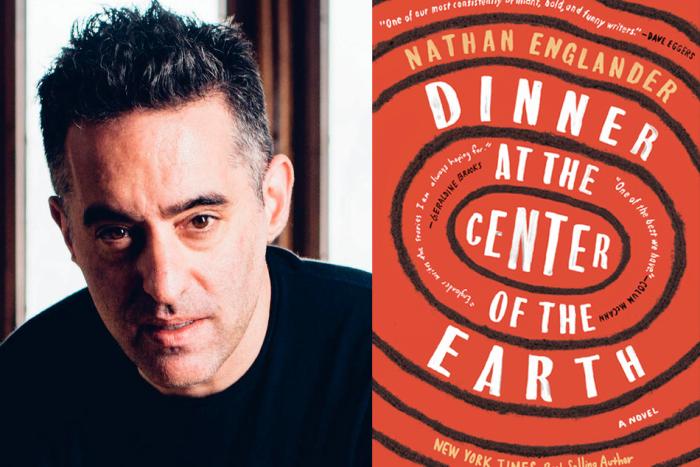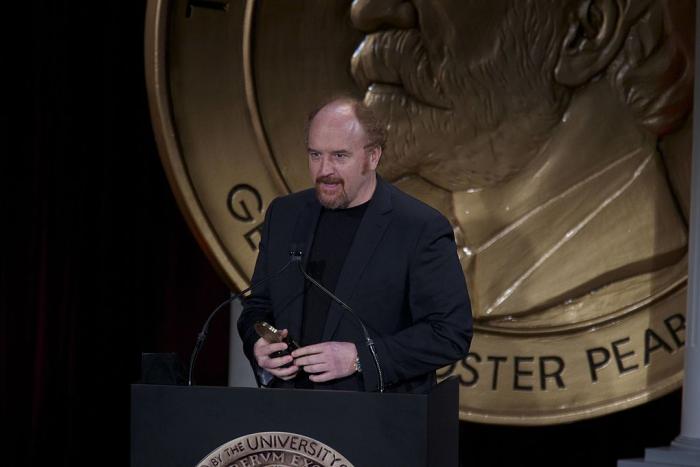New York is a city of zoos. There are five—one in each borough. Most of them are tiny, but still: how many cities in the world can claim five zoos? (There’s also the New York Aquarium, but everyone knows that aquariums are boring.) Earlier this summer, when I took a break from the job that occupied nearly all of my waking hours, I found myself with a great deal of time on my hands, and so I decided to visit a different zoo every day for five days straight. It would be a new way to see New York, I figured; it would bring me places I might not otherwise venture. The city was hot and the world was on fire. Why not go to the zoo?
Day 1: The Staten Island Zoo
On Monday, I took the forty-five-minute train ride from my apartment in Queens to the Whitehall Ferry Terminal in Lower Manhattan. Then I took the half-hour ferry ride to Staten Island. I got an enormous Miller Lite from the ship’s canteen and watched the oxidized green of the Statue of Liberty go by. When I arrived, I took a twenty-minute bus ride that deposited me in a leafy suburb. I walked down a quiet residential street, lined with two-story houses, until I got to the zoo.
I picked the Staten Island Zoo first because Staten Island is a strange, faraway place. In the Africa pavilion, I stopped at an enclosure: Kenya crested guinea fowl, klipspringer, taveta golden weavers, African crested porcupine. I noticed a sign: “The African Porcupines in this exhibit have been generously donated by the Eric Trump Foundation.” My mind flashed to that infamous photo of Eric—or is it Donald Jr.? Is there a difference?—holding a up a severed elephant’s tail, his glazed, inbred face spread into a tight grimace.
The Staten Island Zoo covers eight acres. A woman named Julia Hardin willed the land to the city in 1930, on the condition that it become anything but a playground. In one pen, I watched a zookeeper hose down a pair of emus, while a troop of kangaroos looked on curiously. It was a brutal, blistering day. Nearby, another zookeeper smeared a huge Vietnamese potbellied pig with Banana Boat. “She doesn’t like to go in the mud, so she burns easily,” the zookeeper explained. “We have to put sunblock on her. She likes it.” The pig lolled on her side, eyes closed, in bliss.
Here are some other things I saw at the Staten Island Zoo: a massive green anaconda, its coils motionless in the water, its lidless eyes milky-white. A forty-five-year-old spider monkey, dozing upright, its head jerking back like an old man struggling to stay awake. Pale, eyeless cavefish, something Gollum might eat in The Hobbit. A mass of earth that bubbled and rippled before revealing itself to be an armadillo. A Goeldi’s monkey that put its face to the glass and looked me in the eyes for what felt like hours. I saw a fossa, a binturong, a Mangalitsa.
After I left the zoo, I went for a walk in Clove Lakes Park, across the street. There, in the suburban semi-wild, were cardinals, mockingbirds, an egret skimming the surface of the lake. There was a dead field mouse, flattened by a bike tire, iridescent green bottle flies buzzing all around. Later, the sky opened up, and it poured.
Day 2: The Central Park Zoo
You could write a history of New York via the Central Park Zoo. In 1859, just after construction of the park began, someone gave a bear cub to a park messenger boy. He kept it at the Arsenal, the park’s imposing neo-Gothic headquarters, which, despite the wishes of the Central Park Board of Commissioners, quickly turned into a menagerie. New Yorkers dropped off animals they could no longer care for; sailors brought exotic animals back from long voyages. General George Armstrong Custer donated a rattlesnake; Frederick Law Olmstead gave three coatis. Monkeys, for the sake of modesty, were dressed in human clothing. Asian elephants, their feet chained, grazed on the Arsenal lawn.
Photographs and illustrations from the time, as gathered in Joan Scheier’s The Central Park Zoo, reveal rows of cramped cages, side by side, women in complicated Victorian hats looking in, forlorn animals gazing out. In 1934, Robert Moses, that scourge of contemporary urbanism, was so appalled by conditions at the Central Park Menagerie that he ordered it bulldozed and, with Works Progress Administration help, built the Central Park Zoo in its place. The iron bars and concrete floors remained, but the exhibits were larger, with naturalistic elements like rocks and trees and running water included for a lucky few species. The sea lion pool, still in use today, became the zoo’s hub. The charming Delacorte clock, with its dancing brass animals, was installed in 1964.
But by the 1970s, the Central Park Zoo, like the city around it, was in decline. Gordon Davis, the city’s parks commissioner, wrote in 1981, “The Central Park Zoo, and its Prospect Park companion, are fundamentally 19th-century anachronisms long outdated by modern zoological practices, civilization’s evolving sense of decency and our more sophisticated respect for the world's shrinking animal kingdom.” (He later described the zoo as “Rikers Island for animals.”) So then-Mayor Ed Koch, as he did with so many other persistent municipal problems, outsourced responsibility for the zoo, in this case to the New York Zoological Society. The Central Park Zoo reopened in 1988 as the Central Park Wildlife Center. The exhibits, once again, were made to seem more natural. Mesh and moats and Plexiglas replaced the bars. Most of the large animals were moved to other, bigger zoos. Only the sea lions and polar bears remained.
The day of my visit, I got off the subway at 53rd Street and walked north along Fifth Avenue. Crowds of tourists lined up outside the black-rose obelisk of Trump Tower, taking pictures behind police barricades. I had been to the Central Park Zoo before, but only as a child. Every year, we used to visit my grandparents in Great Neck, and my grandfather, who worked at the New York Public Library his whole life and had an immigrant’s love of the city, would take us into Manhattan. We went up the Statue of Liberty’s crown. We went up the World Trade Center. You could still do that, then.
Apparently we went to the Central Park Zoo, too, but I don’t really remember. I do remember reading, as a child, a book about animal behavior that included a chapter on a polar bear named Gus. In the 1990s, Gus, a resident of the Central Park Zoo, began to swim in obsessive figure-eight patterns, on his back, sometimes for nearly twelve hours a day. His habit was treated as a novelty—ticket sales increased dramatically—but the truth is that Gus was, like a lot of zoo animals, depressed. His zookeepers started an enrichment program, giving Gus toys and hiding food in tough-to-reach places. His habitat was redesigned. An animal behaviorist was brought on board for $25,000. Gus was even given Prozac.
When Gus finally died, in 2013, he was still treated as a novelty act. “There are not a huge number of ways to become famous as a polar bear,” the New York Times wrote, by way of obituary. “Gus somehow managed to do it by behaving like a perfectly ordinary New Yorker: he was neurotic. He became the Neurotic Polar Bear.” But turning Gus into a sort of ursine Woody Allen obscures the fact that his neuroses were entirely avoidable. He was not just another scrappy New Yorker, battling alienation and overstimulation and anonymity, trying to make it in the big city. If he was indeed a New Yorker, then he was one of a different kind, with a different set of problems. He was, essentially, incarcerated.
There are no longer any polar bears at the Central Park Zoo. There are, however, two grizzly bears, which, on the day of my visit, were asleep in the shade. The zoo was crowded with people, even though it was a Tuesday. A little girl picked her nose and stared out at a snow leopard, which panted in the heat. “He wants to eat something,” she announced.
Day 3: The Prospect Park Zoo
The Prospect Park Zoo might be my favorite in New York. It is quieter than the Central Park Zoo, and feels more integrated into the manufactured landscape around it; the grounds are lushly planted, as if the park were slowly seeping in. I like the strange, expressive face of the Pallas’s cat, the angry red of the baboons’ butts. On Wednesday, a peacock battled its own reflection in the glass door of an exhibit marked “Animal Lifestyles.” Watching a Rodrigues fruit bat unfurl its leathery wings, I overheard a conversation between a boy and his mother.
“Anthony, look at the bat,” the woman said. “Oh, look at its wings!”
“I’m scared,” Anthony said.
“But you love Batman,” the woman said.
“I want to go,” Anthony said.
As Anthony dragged his mother away, I became aware, not for the first time, of how weird it was for me, a thirty-one-year-old man, to be at the zoo alone. If contemporary zoos face some existential questions over whether they are primarily conservation operations or entertainment complexes, there is less doubt about their target audience: children. Over the course of my week at the zoos of New York, I was, at all times, surrounded by families—or, especially in Prospect Park, by black nannies pushing white children in strollers.
The centrality of the child to the zoo is a relatively recent development. Early zoos, like Central Park’s, were based on the European menageries of previous centuries—symbols of royal and aristocratic status, such as Louis XIV’s famous collections at Versailles and Vincennes, where dignitaries were entertained with fights between big cats. But later, as industrialization alienated people from the animals they once met on the farm and in the field, what we now know as zoos arose as a form of popular entertainment. “Public zoos came into existence at the beginning of the period which was to see the disappearance of animals from daily life,” the late John Berger writes in the essay “Why Look at Animals?” “The zoo to which people go to meet animals, to observe them, to see them, is, in fact, a monument to the impossibility of such encounters.”
Nowhere is this strange tension more obvious than in the “children’s zoo,” an attraction featured at all five New York zoos. This zoo within a zoo houses domestic farm animals—sheep, goats, pigs, ponies, cows, chickens, geese, ducks, rabbits—which contemporary children rarely see outside of cartoons, or their dinner plates. Children’s zoos are farms in miniature, without the hard labor or ritual slaughter—artificial slices of rural life in the more exotically artificial context of the zoo, which is itself nearly always located in an urban or suburban center. At the Prospect Park children’s zoo, I watched kids put quarters into machines and receive handfuls of brown pellets, which they fed to eager goats. I tried it myself, feeling the animal nibble at my palm.
For many families, the zoo is a formative place. “The family visit to the zoo if often a more sentimental occasion than a visit to a fair or a football match,” Berger writes. In his telling, the purpose of this visit is twofold: to bring children closer to the animals they have encountered in books and films and toys, and, for adults, to recapture the innocence they remember from their own childhood trips to the zoo. But, he writes, there is a problem. “The animals seldom live up to the adults’ memories, while to the children they appear, for the most part, unexpectedly lethargic and dull. (As frequent as the calls of animals in a zoo, are the cries of children demanding: where is he? Why doesn’t he move? Is he dead?) And so one might summarise the felt, but not necessarily expressed question of most visitors as: Why are these animals less than I believed?”
As a child, growing up in southern Ontario, I loved going to the Toronto Zoo. I remember the pervasive scatological funk, the naked mole rats scrabbling blindly in their plastic tunnels, an African elephant unleashing a fire hose of urine. My week at the zoos of New York was, I suppose, an attempt to recall the childlike wonder I felt back then, a wonder uncomplicated by my more ambivalent feelings today about seeing animals in captivity. I still love the sensation of proximity to wildness, to mystery, but this sensation is necessarily tempered by sadness. Even when the animals seem content, even when the exhibits seem ample and well-designed, there remains the distant ache of simulacrum, of containment: the palely painted landscapes on the enclosure walls, the sight of a clipped wing on a bird that might otherwise fly away.
Today, there are no more elephants at the Toronto Zoo. In 2013, after four of them died in as many years, the last three—Iringa, Toka, Thika—were sent to a sanctuary in California. Canada is no place for elephants.
Day 4: The Queens Zoo
By the time Thursday rolled around, I was tired of going to zoos. I headed to Flushing Meadows anyway. At the Queens Zoo, I walked for a time behind a developmentally disabled adult and her parents. She had a gift for description. “He’d make a nice pillow,” she said of a mountain lion. Of a great horned owl, she noted, “The color of his feathers is like chocolate cake.” Then she sprinted, grinning, into the aviary, a geodesic dome designed by Buckminster Fuller.
The Queens Zoo houses only animals from the Americas: eagles, elk, coyotes, bison. The Chacoan peccary, the thick-billed parrot, the Andean bear. It feels wooded, scrubby, like it’s tucked in a forest rather than in Flushing Meadows-Corona Park, the former grounds of the 1964-65 World’s Fair. Walking through the park afterward, I once again sensed the ghost of Robert Moses, who oversaw its transformation for the fair, and I felt like I really needed to get around to reading The Power Broker. Mostly, though, I thought of the hours and hours I spent, as a child, watching Men in Black.
Day 5: The Bronx Zoo
I saved the best for last: the Bronx Zoo. 265 acres, 6,000 animals, perhaps the most famous zoo in the world. I took a long 2 train north, crossed the Bronx River Parkway, and entered the zoo through the iconic Rainey Gates, which are as green as the Statue of Liberty. As I passed, I touched the head of the tortoise in the middle, which has been rubbed back to bronze by so many hands like mine.
If the Central Park Zoo offers a capsule history of New York, then the Bronx Zoo, for better or worse, offers a capsule history of zoos themselves. In 1897, the city granted a tract of land in South Bronx Park to the newly created New York Zoological Society; two years later, the zoo officially opened its doors. Although the New York Zoological Park was primarily intended to help save American wildlife threatened by hunters and habitat loss—it was founded by members of the Boone and Crockett club, a conservation organization—it also amassed a collection of more exotic animals, including, in 1902, a thylacine, a species that, less than two decades later, would be extinct.
The New York Zoological Park was largely the brainchild of a prominent conservationist and man of leisure named Madison Grant, who is credited with helping save the American bison and developing the modern practice of wildlife management. Like many early environmentalists, including his close friend Theodor Roosevelt, Grant was also an avid big-game hunter and a virulent racist. He has mostly been excised from official histories of the Bronx Zoo, thanks to his 1916 book The Passing of the Great Race, a classic of eugenics that Adolph Hitler is said to have called “my Bible.”
In The Passing of the Great Race, Grant combined his twin passions, aiming to save the Nordic people from extinction through a sort of selective breeding program. “Race feeling may be called prejudice by those whose careers are cramped by it, but it is a natural antipathy which serves to maintain the purity of type,” he wrote. “The unfortunate fact that nearly all species of men interbreed freely leaves us no choice in the matter. Either the races must be kept apart by artificial devices of this sort, or else they ultimately amalgamate, and in the offspring the more generalized or lower type prevails.” This does not sound altogether different from the attitude he brought to conservation: “It is of the utmost importance to preserve all remnants of the American bison without any cross-breeding,” he once wrote. It would be nice to separate Grant’s scientific racism from his conservation work were the two not so obviously intertwined: he sought to preserve both a pure white race and a pure frontier for the race to enjoy. Nor was his influence limited to the eugenicist fringe. He helped shape the infamous Immigration Act of 1924, which banned Asians and Arabs and severely restricted Africans, southern Europeans, and Jews. Roosevelt himself blurbed The Passing of the Great Race, calling it “a capital book.”
The connection between conservation and racism was further underscored in 1906, during the most infamous incident in the Bronx Zoo’s history. For a few days that September, a Congolese pygmy named Ota Benga was exhibited in the Monkey House. He shot a bow and arrow for the audience’s amusement; he played with an orangutan; the floor of his cage was littered with bones. “Few expressed audible objection to the sight of a human being in a cage with monkeys as companions,” the New York Times wrote at the time, “and there could be no doubt that to the majority the joint man-and-monkey exhibition was the most interesting sight in Bronx Park.” But the Colored Baptist Ministers’ Conference protested, and Ota Benga’s time as a zoo attraction came to an end.
As detailed in a 2006 New York Times piece marking the controversy’s centenary, Ota Benga’s story is more complicated than his brief time in the spotlight. Sold into tribal slavery by the colonial Force Publique, he was purchased by a South Carolina explorer named Samuel Phillips Verner, who had been commissioned to bring pygmies to St. Louis for the 1904 World’s Fair. The Africans were returned home after the fair, but Ota Benga apparently asked to come back to America, where, while Verner fundraised for future expeditions, the pygmy stayed at the Museum of Natural History, along with a few of Verner’s chimpanzees. When that situation became untenable, Ota Benga moved to the Bronx Zoo. At first, he came and went as he pleased, but it wasn’t long before someone had the idea to set up a more formal exhibit. In the wake of the scandal, Ota Benga moved to the Howard Colored Orphan Asylum, then to Lynchburg, Virginia, where he crossed paths with Booker T. Washington and W.E.B. Du Bois. In March of 1916, he borrowed a gun, aimed it squarely at his heart, and pulled the trigger.
Walking around the Bronx Zoo, in the middle of the poorest borough in New York City, I considered the weight of all this history. Beautiful old Beaux-Arts buildings, which once held lions and elephants, surround the zoo’s stately Astor Court. You can feel the age of the zoo in these places—the sense of grandeur it was meant to project. This was an extension of the zoo’s broader project. “In the 19th century, public zoos were an endorsement of modern colonial power,” Berger writes. “The capturing of an animal was a symbolic representation of the conquest of all distant and exotic lands. ‘Explorers’ proved their patriotism by sending home a tiger or an elephant. The gift of an exotic animal to the metropolitan zoo became a token of subservient diplomatic relations. Yet, like every other 19th century public institution, the zoo, however supportive of the ideology of imperialism, had to claim an independent civic function. The claim was that it was another kind of museum, whose purpose was to further knowledge and public enlightenment.”
As the colonial age ended, and ideas about animal welfare changed, this educational mission came to define the modern zoo—and, it would be fair to say, allowed it to justify its continued existence. If they could no longer be halls of living hunting trophies, if they could no longer be glorified animal jails, then zoos had to be forces for social good. That is the version of the Bronx Zoo that exists today: the one that advertises its work conserving the Amazonian giant river turtle, helping African countries implement National Elephant Action Plans and Strategies, and developing software for anti-poaching patrols. The issue with this formulation—the fact that this worthy conservation work could occur independently of the zoo—is answered with the idea that zoos instil, in their visitors, an appreciation for the natural world. That may be true, and I sincerely hope it is. But, when I stopped by the Bronx Zoo’s polar bear exhibit, I felt not concern for the retreating ice floes of the animal’s natural habitat but, instead, concern for the bear before my eyes. Tundra—the only polar bear left in New York—paced along a concrete wall in his enclosure, back and forth, back and forth. I thought, briefly, of Gus.
Once, shortly after he became a vegetarian, Franz Kafka visited the Berlin aquarium. “Now at last I can look at you in peace,” he said to the fish. “I don’t eat you anymore.” That anecdote, often used as a sort of literary defense of vegetarianism, has less to say about the problem of the aquarium itself; we do not know whether Kafka, gazing in peace at the fish he no longer ate, felt some twinge of guilt at seeing those fish behind glass. My childhood love of animals eventually prodded me to become, like Kafka, a vegetarian, which I kept up for a decade. But I am not one any longer. The scope of cruelty in the world seemed too vast, my refusal to eat meat too small, more a fussy affectation than a principled political stance. It is absolutely true, though, that eating meat is indefensible. So, perhaps, is going to the zoo. I still do both, whatever discomfort they make me feel, and I will probably continue.
That Friday, I continued through the Bronx Zoo. Two massive Nile crocodiles sank to the bottom of their tank like stones. A ring-tailed lemur stole a piece of lettuce from a radiated tortoise with which it shared its enclosure; I wondered what the two animals thought of each other. Later I made my way to the green, expansive, multimillion-dollar western lowland gorilla habitat, where the apes nursed their young and sat cross-legged under the trees. At one point, a gorilla approached the gathered crowd, and I watched in awe as the ape put her knuckles to the glass, as if hoping to make some connection. Her eyes moved over us searchingly. Finally, a child raised his hand to meet hers, Adam reaching out to God.






